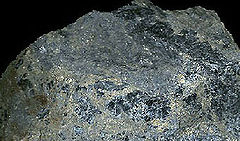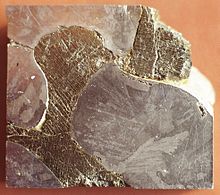- Pyrrhotite
-
Pyrrhotite 
General Category Mineral Chemical formula iron sulfide:Fe1-xS (x = 0 to 0.2) Strunz classification 02.CC.10 Identification Color Bronze, dark brown Crystal habit Tabular or prismatic in hexagonal prisms; massive to granular Crystal system hexagonal, 6/m2/m2/m and monoclinic, 2/m Cleavage Absent Fracture Uneven Mohs scale hardness 3.5 – 4.5 Luster Metallic Streak Dark grey – black Specific gravity 4.58 – 4.65, average = 4.61 Refractive index Opaque Fusibility 3 Solubility Soluble in hydrochloric acid Other characteristics Weakly magnetic, strongly magnetic on heating; non-luminescent, non-radioactive. Pyrrhotite is an unusual iron sulfide mineral with a variable iron content: Fe(1-x)S (x = 0 to 0.2). The FeS endmember is known as troilite. Pyrrhotite is also called magnetic pyrite because the color is similar to pyrite and it is weakly magnetic. The magnetism increases as the iron content decreases, and the troilite is non-magnetic. Troilite can be found as a native mineral on Earth, but is more abundant in meteorites, in particular those originating from the Moon and Mars. Uniform presence of troilite on the Moon and possibly on Mars has been confirmed by the Apollo, Viking and Phobos space probes. The relative intensities of isotopes of sulfur are rather constant in meteorites as compared to the Earth minerals, and therefore troilite from Canyon Diablo meteorite is chosen as the international sulfur isotope ratio standard.
Contents
Etymology and history
The name pyrrhotite is derived from Greek pyrrhos, flame-colored.[1] Troilite is named after Italian abbot Domenico Troili who first noted the mineral in a meteorite that fell in 1766 at Albareto, Modena (Italy). Troili wrote the first description of the fall of a meteorite in a 43-page document published in 1766.[2] He collected reports from many eyewitnesses, closely examined the stone and detected in it small grains of a brassy mineral he called "marchesita", which was long assumed to be pyrite, FeS2. However, in 1862, German mineralogist Gustav Rose analyzed the composition and determined it as FeS. Rose named this new mineral troilite after Troili.[3]
Crystal structure
Pyrrhotite has a number of polytypes of hexagonal or monoclinic crystal symmetry; several polytypes often occur within the same specimen. Their crystalline structure is based on the NiAs unit cell, where metal occurs in octahedral coordination and anions in trigonal prismatic arrangement. An important feature of this structure is an ability to omit metal atoms with the total fraction up to 1/8, thereby creating iron vacancies. One of such structures is pyrrhotite-4C (Fe7S8). Here "4" indicates that iron vacancies form a superlattice which is 4 times larger than the unit cell in the "C" direction. The C direction is conventionally chosen parallel to the main symmetry axis of the crystal; this direction usually corresponds to the largest lattice spacing. Other polytypes include: pyrrhotite-5C (Fe9S10), 6C (Fec11S12), 7C (Fe9S10) and 11C (Fe10S11). Every polytype can have monoclinic (M) or hexagonal (H) symmetry, and therefore some sources label them, for example, not as 6C, but 6H or 6M depending on the symmetry.[1][4]
Troilite has hexagonal structure (Pearson symbol hP24, Space group P-62c No 190). Its unit cell is approximately a combination of two vertically stacked basic NiAs-type cells of pyrrhotite, where the top cell is diagonally shifted.[5] For this reason, troilite is sometimes called pyrrhotite-2C.[4]
Magnetic properties
The ideal FeS lattice, such as that of troilite, is non-magnetic. The ferromagnetism which is widely observed in pyrrhotite is therefore attributed to the presence of relatively large concentrations of iron vacancies (up to 20%) in the crystal structure. Vacancies lower the crystal symmetry. Therefore, monoclinic forms of pyrrhotite are in general more defect-rich than the more symmetrical hexagonal forms, and thus are more magnetic.[6] Upon heating to 320 °C, pyrrhotite loses its magnetism, but also starts decomposing to magnetite. The saturation magnetization of pyrrhotite is 0.12 tesla.[7]
Occurrence
Pyrrhotite is a rather common trace constituent of igneous rocks all over the world. It occurs as segregation deposits from mafic igneous rocks associated with pentlandite, chalcopyrite and other sulfides. It also occurs in pegmatites and in contact metamorphic zones. Pyrrhotite is often accompanied by pyrite, marcasite and magnetite. Pyrrhotite does not have specific applications. It is mined primarily because it is associated with pentlandite, sulfide mineral that can contain significant amounts of nickel and cobalt.[1]
On the contrary, the troilite is extremely rarely encountered in the Earth's crust. (Even pyrrhotite is relatively rare compared to pyrite and Iron(II) sulfate minerals) Most troilite on Earth is of meteoritic origin. One famous iron meteorite, Mundrabilla, which is the 11th heaviest iron meteorite found on Earth,[8] contains 25 to 35 volume percent troilite.[9] The most famous troilite-containing meteorite is Canyon Diablo. Canyon Diablo Troilite (CDT) is used as a standard of relative concentration of different isotopes of sulfur.[10] Meteoritic standard was chosen because of the constancy of the sulfur isotopic ratio in meteorites, whereas the sulfur isotopic composition in Earth materials varies due to the bacterial activity. In particular, bacteria reduce 32SO2−
4 1.07 times faster than 34SO2−
4 that may increase the 34S/32S ratio by up to 10%.[11]Troilite is the most common sulfide mineral at the lunar surface. It forms about 1 % of the lunar crust and is present in any rock or meteorite originating from moon. In particular, all basalts brought by the Apollo 11, 12, 15 and 16 missions contain about 1% of troilite.[5][12][13][14]
Troilite is regularly found in Martian meteorites (i.e. those originating from Mars). Similar to the Moon's surface and meteorites, the fraction of troilite in Martian meteorites is close to 1%.[15][16] Those observations are supported by the measurements performed by Viking 1, by Viking 2 X-ray fluorescence soil analyses and by Phobos-2 orbital γ-ray data.[17][18]
Based on observations by the Voyager spacecraft in 1979 and Galileo in 1996, troilite might also be present in the rocks of Jupiter’s satellites Ganymede and Callisto.[17] Whereas experimental data for Jupiter's moons are yet very limited, the theoretical modeling assumes large percentage of troilite (~22.5%) in the core of those moons.[19]
References
- ^ a b c "Pyrrhotite". Mindat.org. http://www.mindat.org/min-3328.html. Retrieved 2009-07-07.
- ^ Ragionamento della caduta di un sasso ("Concerning the fall of a stone from the air). Modena: Soliani. 1766.
- ^ Gerald Joseph Home McCall, A. J. Bowden, Richard John Howarth (2006). The history of meteoritics and key meteorite collections. Geological Society. pp. 206–207. ISBN 1862391947. http://books.google.com/?id=7SvtVoa1W-cC&pg=PA206.
- ^ a b Hubert Lloyd Barnes (1997). Geochemistry of hydrothermal ore deposits. John Wiley and Sons. pp. 382–390. ISBN 047157144X. http://books.google.com/?id=vy2_QnyojPYC&pg=PA383.
- ^ a b Evans, Ht, Jr (Jan 1970). "Lunar Troilite: Crystallography.". Science 167 (3918): 621–623. Bibcode 1970Sci...167..621E. doi:10.1126/science.167.3918.621. ISSN 0036-8075. PMID 17781520.
- ^ Suna Atak, Güven Önal, Mehmet Sabri Çelik (1998). Innovations in Mineral and Coal Processing. Taylor & Francis. p. 131. ISBN 9058090132. http://books.google.com/?id=fI8Yo0bX7BwC&pg=PA131.
- ^ Jan Svoboda (2004). Magnetic techniques for the treatment of materials. Springer. p. 33. ISBN 1402020384. http://books.google.com/?id=WFBpOXSe8kQC&pg=PA33.
- ^ "iron meteorite". The Internet Encyclopedia of Science. http://www.daviddarling.info/encyclopedia/I/iron_meteorite.html. Retrieved 2009-07-07.
- ^ Vagn Buchwald (1975). Handbook of Iron Meteorites. Univ of California. ISBN 0520029348.
- ^ Julian E. Andrews (2004). An introduction to environmental chemistry. Wiley-Blackwell. p. 269. ISBN 0632059052. http://books.google.com/?id=-JmG0EMtzHwC&pg=PA269.
- ^ Kurt Konhauser (2007). Introduction to geomicrobiology. Wiley-Blackwell. p. 320. ISBN 0632054549. http://books.google.com/?id=sovVNZCj_3QC&pg=PA320.
- ^ Haloda, Jakub; Týcová, Patricie; Korotev, Randy L.; Fernandes, Vera A.; Burgess, Ray; Thöni, Martin; Jelenc, Monika; Jakeš, Petr et al. (2009). "Petrology, geochemistry, and age of low-Ti mare-basalt meteorite Northeast Africa 003-A: A possible member of the Apollo 15 mare basaltic suite". Geochimica et Cosmochimica Acta 73 (11): 3450. Bibcode 2009GeCoA..73.3450H. doi:10.1016/j.gca.2009.03.003.
- ^ Grant Heiken ; David Vaniman ; Bevan M. French (1991). Lunar sourcebook. CUP Archive. p. 150. ISBN 0521334446.
- ^ L. A. Tayrol; Williams, K. L. (1973). "Cu-Fe-S Phases in Lunar Rocks". American Mineralogist 58: 952. Bibcode 1973AmMin..58..952T. http://www.minsocam.org/ammin/AM58/AM58_952.pdf.
- ^ Yanai, Keizo (1997). "General view of twelve martian meteorites". Mineralogical Journal 19 (2): 65. doi:10.2465/minerj.19.65.
- ^ Yu, Y; Gee, J (2005). "Spinel in Martian meteorite SaU 008: implications for Martian magnetism". Earth and Planetary Science Letters 232 (3–4): 287. Bibcode 2005E&PSL.232..287Y. doi:10.1016/j.epsl.2004.12.015. http://ssed.gsfc.nasa.gov/gunther/gunther/YuandGee.pdf.
- ^ a b "Troilite". Mindat.org. http://www.mindat.org/min-4029.html. Retrieved 2009-07-07.
- ^ "Chemical and Mineralogical Composition of the Martian Crust". http://helio.estec.esa.nl/intermarsnet/REDREPORT/node22.html. Retrieved 2009-07-07.[dead link]
- ^ Fran Bagenal, Timothy E. Dowling, William B. McKinnon (2007). Jupiter. Cambridge University Press. p. 286. ISBN 0521035457. http://books.google.com/?id=aMERHqj9ivcC&pg=PA286.
Categories:- Sulfide minerals
- Iron minerals
- Meteorite minerals
- Magnetism
- Hexagonal minerals
Wikimedia Foundation. 2010.


